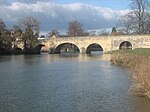Wallingford () is a historic market town and civil parish on the River Thames in Oxfordshire, England, 12 miles (19 km) north of Reading, 13 miles (21 km) south of Oxford and 11 miles (18 km) north west of Henley-on-Thames. Although belonging to the historic county of Berkshire, it is within the ceremonial county of Oxfordshire for administrative purposes (since 1974) as a result of the 1972 Local Government Act. The population was 11,600 at the 2011 census.The town has played an important role in English history starting with the surrender of Stigand to William the Conqueror in 1066, which led to his taking the throne and the creation of Wallingford Castle. The castle and the town enjoyed royal status and flourished for much of the Middle Ages. The Treaty of Wallingford, which ended a civil war known as The Anarchy between King Stephen and Empress Matilda, was signed there. The town then entered a period of decline after the arrival of the Black Death and falling out of favour with the Tudor monarchs before being called on once again during the English Civil War. Wallingford held out as the last remaining Royalist stronghold in Berkshire before surrendering after a 16-week siege. Fearing that Wallingford Castle could be used in a future uprising, Oliver Cromwell ordered its destruction.
Since then Wallingford has become a market town and centre of local commerce. At the centre of the town is a market square with the war memorial and Wallingford Town Hall to the south, the Corn Exchange theatre to the east and numerous shops around the edges. Off the square there are alleyways and streets with more shops and a number of historic inns. Although it was a small town, Wallingford once had 14 churches; now, there are three ancient churches within the Parish of St Mary-le-More and St Leonard, a modern Roman Catholic church, a Quaker Meeting House dating from 1724 and Baptist, Methodist and community churches.









